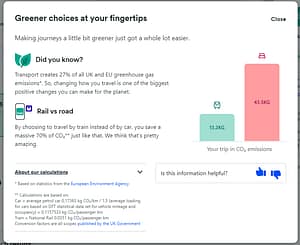Here at SI, our mission is to make the world a better place, one project at a time. And whilst our main sustainability impact is the positive impact we have through our projects, we endeavour to practice what we preach in terms of reducing the environmental impacts of our operations, including our business travel. In this blog, we share some surprising lessons learnt while trying to minimise our travel carbon footprint. With suprising stastics regarding if we should take the ferry or to fly?
With COP27 in full swing this week, global leaders and policymakers have been taking their private jets to Sharm el-Sheikh whilst a few dedicated souls elected to sail or cycle. The contrast of approaches once again stirred the debate about the carbon impact of business travel, particularly when the purpose of the travel is to discuss reducing greenhouse gas emissions!
This is a debate that I often have with myself. Having married a ‘Derry Girl’, I’ve had the pleasure of living in Northern Ireland for the last 11 years. Whilst living in the northwest of Ireland provides many benefits, including an abundance of stunning beaches and coastline, hearty cuisine, and good craic with the locals, it is not the most convenient location to be based when it comes to travelling to the rest of the UK, or internationally, for conferences and client workshops.
The ‘new normal’ ways of working mean that much of our work can now be completed through online meetings and workshops. But when business travel is necessary, I have a big dilemma. Should I take the ferry or fly? I often try to use the ferry as I find it offers a very comfortable and relaxed way to travel and it offers a much lower carbon footprint compared to flying…or so I thought!
Later this month, I will be delivering a TRIZ training workshop for a client in the south of England. In this case, the ferry option would involve the Stena Line Belfast – Liverpool ferry plus a five-hour train journey. The flying option would involve a direct Aer Lingus flight from Belfast City airport. Because of the ferry timings, the ferry plus train option would require an additional night away from home (although with three young children, that can be a blessing – just don’t tell my wife I said that!). It was also significantly more expensive. “Still”, I thought, “the ferry is justifiable in terms of the carbon savings”. To reassure myself of this fact, I decided to do a quick comparison of the carbon footprint of my two options.
For both options, the first part of my journey would be by bus but, as the port and airport are a similar distance from my house, we can ignore that leg of the journey.
Option 1 – Ferry and train
Stena Line does not currently have their own carbon footprint calculator for passenger journeys and so the website directs customers to Travel & Climate.
The journey from Belfast Port to Birkenhead is approximately 260km. Putting this into the calculator gives an estimated carbon footprint of 59 kg CO2e.
For the train section of my journey, thetrainline.com provided an estimated carbon footprint of 13 kg CO2e.
So, the total for the ferry and train option was 72 kg CO2e.
Option 2 – Flight
Aer Lingus does not provide carbon footprint estimates during the booking process. They do have a partnership with Pure Leapfrog, which allows you to offset the carbon emissions of your Aer Lingus flight. This offsetting tool estimated the emissions of my flight to be 70 kg CO2e.
I double checked this by putting the estimated flight distance in the Travel & Climate calculator and got an estimate 71 kg CO2e.
The journey from the airport to the city centre will be short and by train so the impact of this part of the journey will be negligible.
So, the total for the flight option is 70 kg CO2e.
Shock, horror! The ferry is actually slightly worse than flying!? “This can’t be right!” I told myself, so I decided to do dig a bit deeper.
Calculating carbon emissions for a journey simply requires knowing the distance travelled and the ‘emissions factor’ for that mode of transport. The distance is easy enough to estimate using the measuring tool in Google Maps. If there was to be some surprise element it was likely to be related emissions factors.
I went back to Travel & Climate calculator to check the emissions factors they were using for passenger ferry travel. Conveniently, they have published their emissions factors on the website, so I quickly found that they use an emissions factor of 226 grams of CO2e/passenger-km for ferry travel.
I then looked up other reputable sources of emissions factors for passenger ferry travel. Laroche et al.[1] report an emissions factor of 19 grams of CO2e/passenger-km. More than a factor of 10 lower than the value used by the Travel & Climate calculator. Grythe and Lopez-Aparicio[2] report an estimate of 95 grams of CO2e/passenger-km – still less than half of the Travel & Climate value.
At this point, I was feeling happy that the ferry emissions from my journey might be lower than I had initially calculated, but very confused as to why there was such variation in the emissions factors for passenger ferry travel.
I decided to contact the Stena Line sustainability team in the hope that they could provide some clarity. I summarised my findings in an email and asked if they could comment on the emissions factor I should use for the Belfast-Liverpool route.
To their great credit, I received a detailed response from Stena Line within a few days. They explained that the variation in emissions factors is often linked to some key methodological choices. In their own calculations, Stena Line apply the EU Monitoring, Reporting and Verification (MRV) methodology. This requires that the emissions of a vessel be allocated between the passengers and goods transported based on the area occupied. This results in more of the emissions being allocated to the passengers than if the emissions were allocated based on revenue or weight. They also provided the latest emissions factors for the Stena Edda and Embla ferries, which serve the Belfast-Liverpool route (and are published on the EU THETIS platform).
- Jan-Mar 2022: 492 g CO2/passenger-km
- Apr-Jun 2022: 336 g CO2/passenger-km
- July-Sep 2022: 264 g CO2/passenger-km
N.B. These figures do not account for non-CO2 greenhouse gas emissions and so are reported as ‘CO2’ and not ‘CO2equivalent’.
According to Stena Line, the variation across the year is due to the worse weather conditions and lower utilization of passenger capacity in the winter months, and vice-versa.
Interpolating from these figures, my ferry journey in November might have an emissions factor of around 400 g CO2/passenger-km. This would give a Belfast-Liverpool journey carbon footprint of:
260 km x 0.4 kg CO2/passenger-km = 104 kg CO2
With the train leg adding a further 13 kg CO2, the ferry and train option, appears to be 46 kg CO2 (65%) worse than the flight option.
For balance, I checked some other sources for estimates of the flight emissions, resulting in the following estimates:
- 70 kg CO2e – Pure Leapfrog
- 71 kg CO2e – Travel & Climate
- 130 kg CO2e – World Land Trust
- 149 kg CO2e – MyClimate
- 152 kg CO2e – Clevel
There is still some significant variation in these estimates but less than the factor 10 variation I found in the ferry emissions estimates.
If we take the average value of the flight carbon emissions estimates, 114 kg CO2e, and compare that with the ferry plus train option, 117 kg CO2, we find they are very similar.
So, after all that digging what can we conclude from this exercise?
- “Show me the numbers!” This was always the response from a certain professor at the University of Bath to any assertion about something being ‘more sustainable’. In this case, the numbers have proved me wrong in my assumption that the carbon footprint of ferry travel is significantly lower than flying. When in doubt, check the numbers.
- We need to give travellers easier access to carbon footprint data. Most travel sites still do not present carbon footprint data to the user, and I often had to manually calculate distances and input them into a 3rd party carbon calculator to get an estimate. Thumbs up to thetrainline.com for integrating this information into the booking process (see below). Stena Line has also confirmed that they are planning to offer travel customers a carbon footprint calculation in their booking system.

Carbon footprint calculation from thetrainline.com.
- We need better standardisation of carbon footprinting methodologies. The factor 10 variation in emissions factor for passenger ferry travel was puzzling but could be explained to some extent by the differences in allocation methodologies. From a consumer perspective, if they encounter such wildly different estimates of carbon footprint from one source to another, the likelihood is that they will become confused, frustrated, and lose trust in the data. If governments, NGOs, and industry want consumers to make carbon-literate choices, they need to ensure that consumers have access to consistent, high-quality carbon footprint data. Hopefully, standardisation activities, such as ISO 14083, will help in this challenging endeavour.
So, should I fly or take the ferry? I still have many questions about the accuracy of the carbon footprint estimates I’ve come across and the consequences of my choices. Do the estimates account for effective radiative forcing? Will taking the ferry regularly support more sustainable innovation in the ferry industry, such as carbon negative marine biofuels? Should I take the ferry in the Summer but not the Winter? Could I absolve my soul of carbon guilt by purchasing carbon offsets? Etc. I guess, the unending questions and existential angst are just part of the joy of being a sustainable innovation consultant! Please let me know your thoughts on my dilemma in the comments.
[1] Laroche et al. (2023). https://www.sciencedirect.com/science/article/pii/S0261517722001431
[2] Grythe and Lopez-Aparicio (2021). https://www.sciencedirect.com/science/article/pii/S2666765721000752
